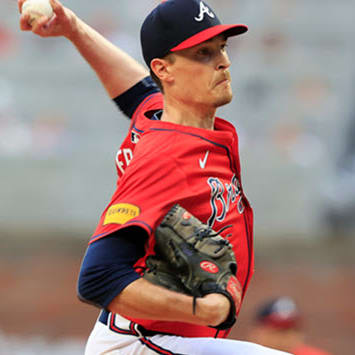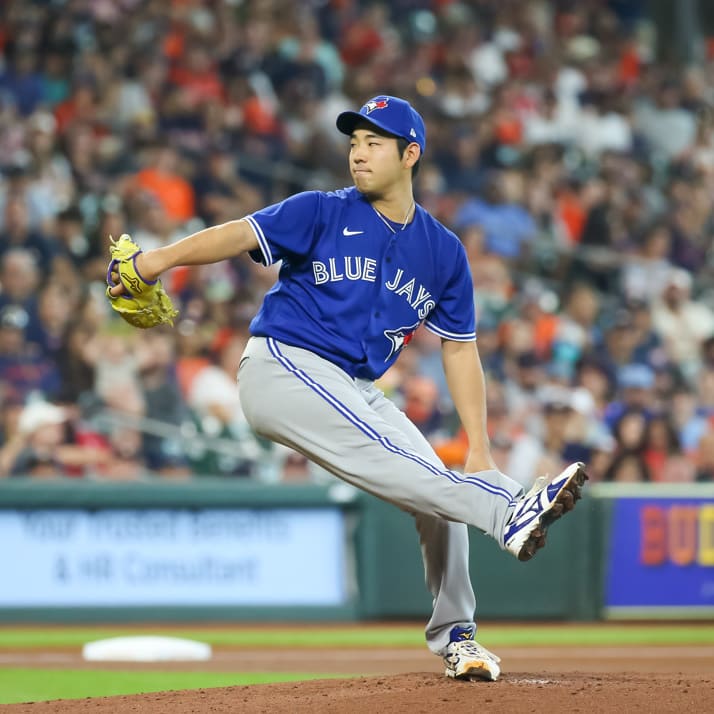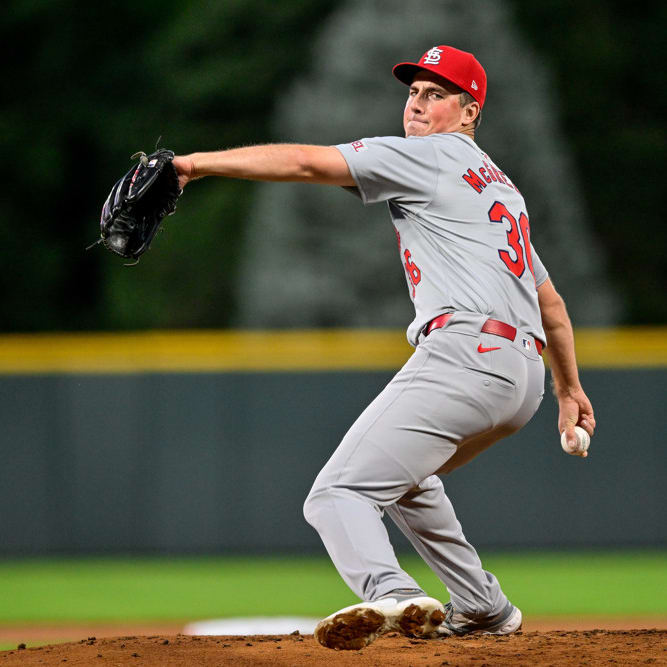This article is part of our Farm Futures series.
Eloy Jimenez, OF, Cubs
Jimenez was the best prospect in the AFL for dynasty league purposes and will enter 2017 in the top 10 on RotoWire's prospect rankings. He projects to have a plus-plus hit tool and plus power, which will more than make up for his fringe average speed and lack of high-end defensive value.
In Friday's game against Scottsdale, he laced two doubles the other way off James Kaprielian (one was scored a single, with him advancing to second on an error by Tyler Wade, but that was an error by the official scorer). If he gets pitched inside, he rips it the other way. If the pitcher tries to use the outer half, Jimenez sends ropes to right field. This is one of the best natural hitters in the minors. He only walked at a 5.4 percent clip last year, but it's hard to expect him to be patient when he is hitting .329 with a 162 wRC+. Look for him to start taking more walks as he moves up the ladder. The Cubs don't need to make room for him in the outfield for a couple years, but when he is ready, nobody will stand in his way.
Cody Bellinger, 1B, Dodgers
This was my first time seeing Bellinger in person, and he was impressive, for the most part. My physical comp for him from seeing video was Brandon Belt, but the obvious comp after seeing him up close is Anthony Rizzo. He is not as thick or imposing as Rizzo, but the approach is very similar. Bellinger crowds the plate and stands way back in the box, to the point that an opposing manager could argue that he is illegally out of the box. This is all an attempt to coax the pitcher into attacking him inside so that he can pull the ball out to right field. Like Rizzo, Bellinger loads up for his pitch, and can end up down on one knee, or even flailing out of the box when he whiffs. This may seem concerning, but this is an advanced hitter who won't turn 22 until July, and at that point he could be in the big leagues. While I'm not concerned long term, his approach suggests there will be some struggles over his first 500 plate appearances against major league pitching.
He is an athletic 6-foot-4, 213 pounds, and could probably handle the corner outfield spots, and there are some who even think he could be adequate in center field. This is only relevant because Adrian Gonzalez is signed through 2018, so Bellinger's best chance of getting into the Dodgers lineup over the next couple years may be as an outfielder.
Bellinger yanked one out to right field off Jared Miller in the Fall Stars game, and also struck out twice, which is his game in a nutshell. There is no doubt he has plus power and will take his fair share of walks, but it is unclear what type of batting average he will bring to the table, or whether he will be able to keep his strikeout rate in an acceptable range. His athleticism and high aptitude for the game lead me to believe he will settle in as at least a .260 hitter with 25-plus homer power, with plenty of room for more if he maxes out.
Gleyber Torres, SS, Yankees
Torres is slightly thicker than the typical 6-foot-1, 19-year-old shortstop prospect, but he displayed excellent range and actions at shortstop in the AFL, and most evaluators seem to be convinced that he will stick at shortstop long term, which was not the case a year ago. In real life terms, he may have been the best prospect in Arizona, as he could be a plus defender up the middle and also projects to be an above average hitter.
He walked three times in Friday's game against Mesa, but he struck out three times in the Fall Stars game, which suggests he may have been trying a little too hard to put on a show on the big stage. On the whole, he is hitting .300/.451/.575 with three home runs, two steals and a 5:11 K:BB in 12 games for Scottsdale, so he has a good handle on the plus velocity AFL hurlers typically bring to the table, while also showing a willingness to walk when pitchers aren't commanding their stuff, which is often the case in Arizona.
Torres stole 21 bases at High-A, but he is not a plus runner, and projects to be more of a 10-15 steal threat in the big leagues. His power and hit tool will be what defines his value. Many evaluators think he will be a 15-homer threat, but I could also see him topping that and hitting 20-plus annually in his prime seasons. Torres is a safe bet to bring at least an average hit tool and a good approach to the big leagues, but if he maxes out we could be looking at a .285 hitter with 20-homer pop and double-digit steals while hitting first or second in the order. He should start his age-20 season at Double-A with a chance to receive a promotion to Triple-A by season's end.
Michael Kopech, RHP, Red Sox
This is the guy I was most excited to see in Arizona, and Kopech did not disappoint. He threw two perfect innings of relief and struck out three in the Fall Stars game. Initially he was parked at 96-99 mph with his fastball, but the command was fringe average at best. In his second inning, however, he took a couple ticks off his heater in order to better locate the pitch. His slider will flash plus, but he hardly needs it the first time through a lineup. The development of his changeup and continued refinement of his command will be critical for him to continue on a starter's track.
He was fittingly referred to as "baby Syndergaard" by several evaluators over the weekend, and it fits. For that to be true of a 20-year-old speaks volumes about his potential. He is a top five pitching prospect in the game, even though he has not pitched above High-A and is not a lock to make it as a starter.
Franklin Barreto, SS/2B, A's
Barreto already started playing some second base with Double-A Midland (31 starts), and while he played shortstop in four games with Triple-A Nashville and in the AFL, he is not going to stick there at the highest level. He has the arm of a second baseman and the range and actions of a third baseman, but considering Ryon Healy looks like the real deal at third, Barreto's future home should be the keystone, where his bat will carry the profile.
He has been awful at the plate in the AFL, but it's hard to read too much into that, given the small sample size and the fact that he just got done with a full year at Double-A as a 20-year-old. He might just be physically and mentally drained.
Joey Wendle and Chad Pinder figure to get looks at second base in the short term, but if neither seizes the job, Barreto could take over sometime this summer. He has the potential for 10-15 homers and 20-30 steals over a full season, and his hit tool has a chance to be plus. Considering he would likely hit in the top half of the A's lineup, that across the board production could add up to a top-10 fantasy second baseman during his peak years.
Tyler O'Neill, OF, Mariners
O'Neill was the strongest player in the AFL, with forearms that would put most big leaguers to shame. He has a muscular, compact 5-foot-11 frame that generates plus power, but he seems to sell out for it. His minor league numbers are pretty eye-popping and while the power is legitimate, there are those who don't think his hit tool will play better than average against big league pitching. The power and approach will be enough for him to play every day, but it is unclear if he will be a .240 hitter or if he will be able to make the necessary adjustments to hit in the .260-.280 range.
James Kaprielian, RHP, Yankees
Kaprielian has as much upside as any pitcher in the AFL not named Kopech. I love the way he works. He operates with a "give me the ball and get out of the way" mentality. His durability and the resting velocity of his fastball at maturity while handling a starter's workload are legitimate question marks though. If he sits 94-95 while showing a wipeout slider and plus changeup, then he is a front line starter. If he only sits 92-93, he might be a mid-rotation arm. If he can't stay healthy while building up his innings, he's a reliever, at best. I love the physical profile and he projects to have plus command. Given the repertoire, this is an arm I'd be willing to bet on, as the upside is immense and it might not take him long to cruise through the minors.
Brent Honeywell, RHP, Rays
Honeywell is an arm dynasty leaguers and single-season owners should be getting excited about. He excelled in 10 starts at Double-A last year and was dominant in two shutout innings in the Fall Stars game, striking out five while allowing zero baserunners. His plus screwball, a pitch that is rarely seen in the majors, is one of the most well-known pitches in the minors. His second best offering is a low-90s fastball. One problem with Honeywell is that he has a five-pitch mix that he insists on utilizing, and it is a situation where a pitcher has too many toys, and would be better off if he just picked three to work with, at least at this stage in his career. His overall approach to pitching seems reminiscent to Trevor Bauer, where his stubbornness could end up getting him on the wrong side of catchers and coaches. He has all the tools to be a quality No. 3 starter, and he should get a chance in Tampa Bay's rotation sometime this summer.
Bradley Zimmer, OF, Indians
Zimmer showed off some impressive power in Friday's game against Scottsdale, taking Kaprielian yard to left-center field -- an impressive feat for a left-handed hitter against one of the best pitchers in the AFL. The long-levered center fielder rests his bat on his shoulder and there are a lot of moving parts when he decides to swing, which helps explain his 171 strikeouts in 130 games last year. The power and speed are pretty obvious (he already has seven steals in 15 AFL games), and he walks a ton, so he could still hit fairly high in the order. But it's pretty clear at this point that he won't be offering much more than a .250 average in the majors.
Francis Martes, RHP, Astros
Martes has made a lot of progress over the past year, but I am starting to think he would fit best as a relief ace. He has two potentially double-plus pitches in his fastball and curveball, although his fastball can straighten out a little, so it's unclear whether that would actually be a true 70-grade pitch against big league hitters. Martes misses his spots too often for my liking, and his changeup is a fringe average offering. The Astros will likely continue developing him as a starter for now, but in three years my bet is that he'll be a dominant reliever capable of logging multiple innings at a time.
Willie Calhoun, 2B, Dodgers
Calhoun is a fun guy to watch. Dan Uggla thinks his pumpkin-shaped body could use some work, but he absolutely rakes against right-handed pitching, launching balls to the pull side. He went 3-for-3 with a home run en route to MVP honors in the Fall Stars game, which should slightly increase his name value this offseason. It is important that everyone understands what Calhoun is, without overreacting to his power production (27 homers) last year at Double-A. He is essentially Scooter Gennett with pop. He makes the routine plays, but no team is ever going to be happy with his defense at second base, and he does not really profile anywhere else. It will also be difficult to write him into the lineup against southpaws.
Michael Gettys, OF, Padres
A case could be made that Gettys has the best pure tools of any position player in the AFL. He is a 70-grade runner and has above average raw power. Despite his big numbers last year at Low-A and High-A, he struck out a bunch and posted BABIPs over .400 at both stops. His hit tool is below average. He is still just 21 years old, but it's not often that hitters with his profile figure it all out. His tools will get him to the big leagues, but when he gets there, it might not take long for him to be pigeonholed as a part-time player.
Harrison Bader, OF, Cardinals
Bader is a gamer with a solid, compact frame, who can play all three outfield spots. He generates above average power, particularly against lefties, while also offering average speed on the bases. Offspeed pitches gave him a lot of trouble in the Fall Stars game, as he doubled and singled off fastballs in his first two at-bats, then struck out in the next two on a steady dose of curveballs and changeups. I'm very confident that he can at least occupy the short side of a platoon in the outfield as early as this summer, but it's unclear if he will hit enough against righties to garner a full-time role.
Garrett Stubbs, C, Astros
Of the players I saw in Arizona who are a little off the radar, this is my guy. Stubbs had five quality plate appearances Friday against Peoria, making a couple loud outs while ripping a double and drawing a walk. At 5-foot-10, Stubbs' slight frame does not profile behind the dish, but he is pretty athletic and threw out a would-be base stealer in that game. He also displayed elite makeup on the field. If he was 6-foot-2, we would be talking about a top-100 prospect in the game. Instead he lingers on the periphery as a potential starting catcher with a plus hit tool, excellent approach and sneaky 10-15 homer pop.
Brett Phillips, OF, Brewers
I want to like Phillips, but this is a pretty flawed offensive player at the moment. He has a cannon of an arm in right field and has some speed and pop, but the hit tool looks pretty fringy. His bat looks slow against premium velocity, which explains the increased strikeout rate as he has moved up the ranks. Phillips also really struggles against left-handed pitching. His defensive tools will give him plenty of opportunities, and he has good makeup, so he could realistically improve in his areas of weakness, but right now this looks like a glove-first outfielder who sits against southpaws. That said, the time to try to shop Phillips in deep dynasty leagues will be after he has played a few homestands in Colorado Springs this spring/summer.
Jacob Nottingham, C, Brewers
Nottingham is a hulking specimen of a man, with big time raw power. Unfortunately, the growing sentiment among evaluators is that he has no chance of sticking behind the plate. The Brewers understandably won't pull the plug on him catching anytime soon, but this is an important reality to be aware of. If he can't catch, he's a first baseman, and based on how stiff his movements are, he will probably be a below-average defender at first base as well. This means he is going to really have to hit, which is asking an awful lot of a player who struck out at a 30.3 percent clip last year.
David Paulino, RHP, Astros
Here is another Astros pitching prospect with two potentially plus pitches who I think ends up in the bullpen. He has a lean 6-foot-7 frame, but I hate his body as much as I hate Calhoun's. He is very high-waisted and his movements are unathletic. The spin rate on his curveball is excellent, and his fastball sits in the low-to-mid 90s, playing up a bit in short stints. He also throws a lot of strikes for someone his size. I just don't like it. It's hard to properly explain it, but I would be shocked if he had a long run of success as a starter.











